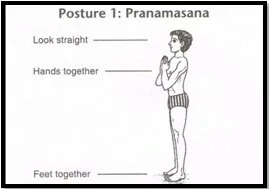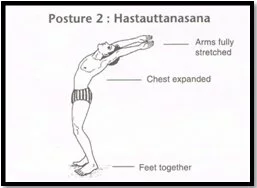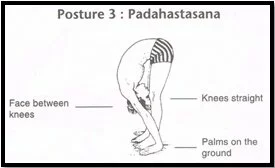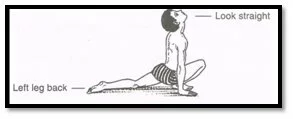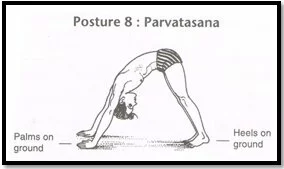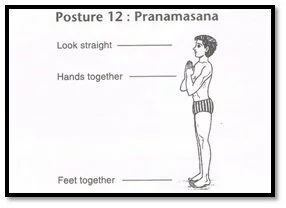Reference:-
http://aboutyoga.in/surya-namaskar/
Surya Namaskara (IPA: [suːrjɐ nɐmɐskɐːrɐ]; Sanskrit: सूर्य नमस्कार; IAST: Sūrya Namaskāra) also known in English as Sun Salutation (lit. “salute to the sun”) is a common sequence of asanas. Its origins lie in India where they worship Surya, the Hindu solar deity. This sequence of movements and asanas can be practised on varying levels of awareness, ranging from that of physical exercise in various styles, to a complete sadhana which incorporates asana, pranayama, mantra and chakra meditation. It is often the beginning vinyasa within a longer yoga series. Sūrya Namaskāra may also refer to other styles of “Salutations to the Sun”.
The human being can be thought of consisting of ‘pancha kosas’ (or five sheaths) consisting of the Annamaya (or Body), Pranamaya (or Breath), Manomaya (or Mind), Vijnanamaya (or Intellect) and Anandamaya (or Bliss) sheaths. These same five kosas can be further grouped into Gross (or Sthula), the Annamaya or body sheath, Subtle (or Sukshma) consisting of the pranic, mental and intellectual sheaths and the Causal (or Karana), the Bliss sheath. Properly performed Surya Namaskar impacts and influences all five sheaths – the body, the breath, the mind, the intellect and the bliss – thus providing to the performers of these exercises the benefits for the Sthula (Gross), Sukshma (subtle) and Kaarana (Causal) bodies. Whereas conventional exercises of all forms including aerobic, weight lifting, walking, jogging and running are designed to provide benefits to the physical body and its various component organs including joints and muscles, Surya Namaskar provides benefits of a holistic nature by working on the physical body, praana (breathing), mind, intellect and the bliss components (or kosas) of the entire human personality. In that sense, Surya Namaskar can be considered to be a personality development tool and must be included as part of one’s wellness program.
Benifits:-
This beautiful set of yoga postures work not only on the body but also on the mind and at the spiritual level.
If you have been doing Sun Salutation so far only to shed off those extra inches, here’s some food for thought. This wonderful gift of yoga, if practiced regularly, can work wonders for every part of the body – from head to toe.
Sun Salutation (also known as Surya Namaskar) is a set of 12 yoga postures that helps improve overall health and well being.
Sun Salutation impacts every organ of the body:
The Sun Salutation sequence, if done at a fast pace can be a good way to lose weight and is an excellent cardiovascular workout as well – stretching and toning the muscles in the entire body. But that’s not all. This yoga sequence improves the circulation of blood throughout the body and helps in maintaining good health by ensuring a disease-free body.
Daily practice of Surya Namaskar has numerous benefits to offer for the digestive, respiratory, and circulatory system.
Develop your sixth sense with Sun Salutations:
Different organs of our body are governed by different Gods. The solar plexus, or the navel, is connected with the Sun (for which reason it is called the “solar” plexus). Although Sun Salutation can be practiced at any time of the day, morning or evening, it is a good idea to do it at the time of sunrise. When the first rays of the Sun fall on the solar plexus, it is good for the body.
Usually, the navel is slightly bigger in size than an almond. Studies have shown that with the practice of yoga, Sun Salutation, meditation, and Kriya, the solar plexus can become as large as the size of the palm. It then performs better, balances the body functions. When the solar plexus contracts, depression and other kinds of negative emotions come up. When it expands, the intuitive mind works better, becoming more clear and focused.
The solar plexus has a profound impact on the central nervous system, optic nerves, stomach, and what we usually call the ‘gut feeling’ or intuition. Solar plexus is also considered the second brain in the body. And Surya Namaskar directly works on this important organ.
A spiritual experience with Sun Salutation:
Besides offering physical benefits, the Sun Salutation practice also helps calm the mind. Doing a few rounds of Surya Namaskar at an easy pace can be very relaxing and meditative. And adding a touch of gratitude to the Sun, chanting mantras while doing Sun Salutation, adds a whole spiritual dimension to the practice, making it more sacred.
Kids and adults: Sun Salutation benefits all:
The physical and spiritual benefits of Sun Salutation are not just for adults to enjoy. Surya Namaskar is equally a lot of fun for children, while individually addressing particular parts of their body, both anatomically and physiologically. You can make your child learn Sun Salutation.
So, while practice Sun Salutation, know that it’s benefiting you at different levels. Simply being aware of this can help enhance your experience and help you go deeper in your practice.
Practice:-
Surya Namaskara, like most asanas, is recommended to be performed on an empty stomach. Therefore some recommend a gap of at least two hours after eating and before performing the namaskara. It is generally practiced in the morning before breakfast or in evening.
- Shavasana is practiced at the end of practice for rest.
- Pranayama is synchronized with asanas.
- Mantras can be pronounced at the start of each Surya namaskara. Bījas (seeds) or the 12 mantras specific to each asana can also be chanted while performing each asana. The 12 specific mantras, though, repeated mentally instead.
- Chakras are points-of-focus, when performing asanas.
- There are a total of 8 different asanas in the sequence of the 12 asana changes of Surya namaskara. Some asanas are repeated twice in the same cycle of a Surya Namaskara.
- In a traditional Hindu context, Surya Namaskara is performed facing in the direction of the rising (east) or setting (west)sun.
- As per the scriptures one who performs the Surya Namaskaras daily does not get poor in a thousand births.
There are 5 ways in which breathing should be done during Surya Namaskar.
The following lists Surya Namasakar A. Other variations including Surya Namasakar B exist.
The following lists Surya Namasakar A. Other variations including Surya Namasakar B exist.
Step by Step:-
Step #1: Pranamasana (Prayer pose)
Stand at the edge of your mat, keep your feet together and balance your weight equally on both the feet.
Expand your chest and relax your shoulders.
As you breathe in, lift both arms up from the sides and as you exhale, bring your palms together in front of the chest in prayer position.
Expand your chest and relax your shoulders.
As you breathe in, lift both arms up from the sides and as you exhale, bring your palms together in front of the chest in prayer position.
Step #2: Hastauttanasana (Raised arms pose)
Breathing in, lift the arms up and back, keeping the biceps close to the ears. In this pose, the effort is to stretch the whole body up from the heels to the tips of the fingers
How to deepen this yoga stretch?
You may push the pelvis forward a little bit. Ensure you’re reaching up with the fingers rather than trying to bend backwards.
How to deepen this yoga stretch?
You may push the pelvis forward a little bit. Ensure you’re reaching up with the fingers rather than trying to bend backwards.
Step #3: Hasta Padasana (Hand to foot pose)
Breathing out, bend forward from the waist, keeping the spine erect. As you exhale completely, bring the hands down to the floor, beside the feet.
How to deepen this yoga stretch?
You may bend the knees, if necessary, to bring the palms down to the floor. Now make a gentle effort to straighten the knees.
It’s a good idea to keep the hands fixed in this position and not move them henceforth until we finish the sequence.
How to deepen this yoga stretch?
You may bend the knees, if necessary, to bring the palms down to the floor. Now make a gentle effort to straighten the knees.
It’s a good idea to keep the hands fixed in this position and not move them henceforth until we finish the sequence.
Step #4: Ashwa Sanchalanasana (Equestrian pose)
Breathing in, push your right leg back, as far back as possible. Bring the right knee to the floor and look up.
How to deepen this yoga stretch?
Ensure that the left foot is exactly in between the palms.
How to deepen this yoga stretch?
Ensure that the left foot is exactly in between the palms.
Step #5: Dandasana (Stick pose)
As you breathe in, take the left leg back and bring the whole body in a straight line.
How to deepen this yoga stretch?
Keep your arms perpendicular to the floor.
How to deepen this yoga stretch?
Keep your arms perpendicular to the floor.
Gently bring your knees down to the floor and exhale. Take the hips back slightly, slide forward, rest your chest and chin on the floor. Raise your posterior a little bit.
The two hands, two feet, two knees, chest and chin (eight parts of the body touch the floor).
Step #7: Bhujangasana (Cobra pose)
Slide forward and raise the chest up into the Cobra posture.You may keep your elbows bent in this pose, the shoulders away from the ears. Look up.
How to deepen this yoga stretch?
As you inhale, make a gentle effort to push the chest forward; as youexhale, make a gentle effort to push the navel down. Tuck the toes under. Ensure you’re stretching just as much as you can; do not force.
Slide forward and raise the chest up into the Cobra posture.You may keep your elbows bent in this pose, the shoulders away from the ears. Look up.
How to deepen this yoga stretch?
As you inhale, make a gentle effort to push the chest forward; as youexhale, make a gentle effort to push the navel down. Tuck the toes under. Ensure you’re stretching just as much as you can; do not force.
Step #8: Parvatasana (Mountain pose)
Breathing out, lift the hips and the tail bone up, chest downwards in an ‘inverted V’ (/\) posture.
How to deepen this yoga stretch?
If possible, try and keep the heels on the ground and make a gentle effort to lift the tailbone up, going deeper into the stretch.
How to deepen this yoga stretch?
If possible, try and keep the heels on the ground and make a gentle effort to lift the tailbone up, going deeper into the stretch.
Step #9: Ashwa Sanchalanasana (Equestrian pose)
Breathing in, bring the right foot forward in between the two hands, left knee down to the floor, press the hips down and look up.
How to deepen this yoga stretch?
Place the right foot exactly between the two hands and the right calf perpendicular to the floor. In this position, make a gentle effort to push the hips down towards the floor, to deepen the stretch.
How to deepen this yoga stretch?
Place the right foot exactly between the two hands and the right calf perpendicular to the floor. In this position, make a gentle effort to push the hips down towards the floor, to deepen the stretch.
Step #10: Hasta Padasana (Hand to foot pose)
Breathing out, bring the left foot forward. Keep the palms on the floor. You may bend the knees, if necessary.
How to deepen this yoga stretch?
Gently straighten the knees and if you can, try and touch your nose to the knees. Keep breathing.
How to deepen this yoga stretch?
Gently straighten the knees and if you can, try and touch your nose to the knees. Keep breathing.
Step #11: Hastauttanasana (Raised arms pose)
Breathing in, roll the spine up, hands go up and bend backwards a little bit, pushing the hips slightly outward.
How to deepen this yoga stretch?
Ensure that your biceps are beside your ears. The idea is to stretch up more rather than stretching backwards.
How to deepen this yoga stretch?
Ensure that your biceps are beside your ears. The idea is to stretch up more rather than stretching backwards.
Step #12: Tadasana
As you exhale, first straighten the body, then bring the arms down. Relax in this position, observe the sensations in your body.
As you exhale, first straighten the body, then bring the arms down. Relax in this position, observe the sensations in your body.
Mantras:-
13 Surya Namasakras are practised per cycle.
In the table, the following first 12 mantras corresponds to the 12 asanas in Surya Namasakara and can also be chanted or repeated mentally during the performance of each corresponding asana. They can also be pronounced at Pranamasana.
13 Surya Namasakras are practised per cycle.
In the table, the following first 12 mantras corresponds to the 12 asanas in Surya Namasakara and can also be chanted or repeated mentally during the performance of each corresponding asana. They can also be pronounced at Pranamasana.
SALUTATION | SANSKRIT | TRANSLITERATION |
1 | ॐ मित्राय नमः | OM MITRĀYA NAMAḤ |
2 | ॐ रवये नमः | OM RAVAYE NAMAḤ |
3 | ॐ सूर्याय नमः | OM SŪRYĀYA NAMAḤ |
4 | ॐ भानवे नमः | OM BHĀNAVE NAMAḤ |
5 | ॐ खगाय नमः | OM KHAGĀYA NAMAḤ |
6 | ॐ पूष्णे नमः | OM PUṢṆE NAMAḤ |
7 | ॐ हिरण्यगर्भाय नमः | OM HIRAṆYA GARBHĀYA NAMAḤ |
8 | ॐ मरीचये नमः | OM MARĪCAYE NAMAḤ |
9 | ॐ आदित्याय नमः | OM ĀDITYĀYA NAMAḤ |
10 | ॐ सवित्रे नमः | OM SAVITRE NAMAḤ |
11 | ॐ अर्काय नमः | OM ARKĀYA NAMAḤ |
12 | ॐ भास्कराय नमः | OM BHĀSKARĀYA NAMAḤ |
13 | ॐ श्रीसवितृसूर्यनारायणाय नमः | OM ŚRĪSAVITṚSŪRYANĀRĀYAṆĀYA NAMAḤ |
The following mantra is pronounced at the beginning of a Surya Namaskara cycle:
ॐ ध्येयः सदा सवित्र मण्डल मध्यवर्ती नारायण सरसिजा सनसन्नि विष्टः
केयूरवान मकरकुण्डलवान किरीटी हारी हिरण्मय वपुर धृतशंख चक्रः
om dhyeyaḥ sadā savitra maṇḍala madhyavartī nārāyaṇa sarasijā sanasanni viṣṭaḥ
om dhyeyaḥ sadā savitra maṇḍala madhyavartī nārāyaṇa sarasijā sanasanni viṣṭaḥ
keyūravāna makarakuṇḍalavāna kirīṭī hārī hiraṇmaya vapura dhṛtaśaṁkha cakraḥ
The following mantra is pronounced at the end of a Surya Namaskara cycle:
आदित्यस्य नमस्कारन् ये कुर्वन्ति दिने दिने
आयुः प्रज्ञा बलम् वीर्यम् तेजस्तेशान् च जायते
आयुः प्रज्ञा बलम् वीर्यम् तेजस्तेशान् च जायते
ādityasya namaskāran ye kurvanti dine dine
āyuḥ prajñā balam vīryam tejasteśān ca jāyate
āyuḥ prajñā balam vīryam tejasteśān ca jāyate
For those who salute the sun every day, life expectancy, conscious, strength, courage and vital power shall grow.

